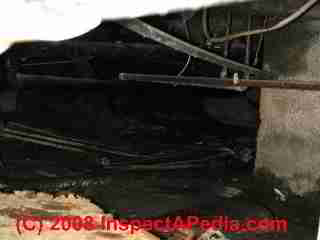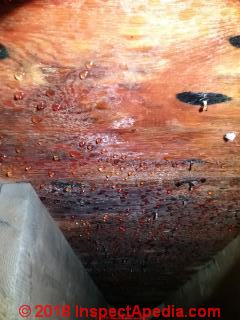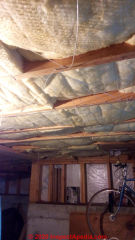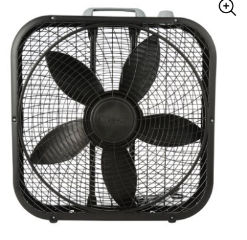 Dry Out the Crawl Space in 3 Steps
Dry Out the Crawl Space in 3 Steps
Methods to rapidly & thoroughly dry out a wet crawl area after water entry or flooding
- POST a QUESTION or COMMENT about how to dry out a wet crawl space & prevent future crawl space water entry
How to fix up a wet crawl space:
Three key steps to get water and moisture out of a building crawl area following water entry, storm flooding, or a sewer backup. Here we summarize a safe and effective approach to removing water from a wet or flooded crawl space.
Companion articles add details about debris removal, cleaning, and sanitizing a crawl area followed by advice on how to keep the crawl space dry.
InspectAPedia tolerates no conflicts of interest. We have no relationship with advertisers, products, or services discussed at this website.
How to Dry Out a Crawl Space Quickly in Three Steps
 Here is a Step by Step Guide to Drying out the Crawl Area and Keeping it Dry.
Here is a Step by Step Guide to Drying out the Crawl Area and Keeping it Dry.
Watch out: as we detail at CRAWL SPACE SAFETY ADVICE, entering a wet crawl area is dangerous, involving shock hazards and possible chemical or sewage contaminants.
And see our complete list of crawl space dryout steps at
CRAWL SPACE DRYOUT
Photo: droplets of water soaking the under-side of plywood subfloor over a wet crawl area, contributed by an anonymous reader, 2018/03/04
[Click to enlarge any image]
Step 1: Remove crawl space debris and wet materials - without this step the dry-out will be more difficult, take more time, and be more dangerous.
Do not try to "dry out" wet or damp or suspect fiberglass crawl space insulation. Just remove and discard it. But don't insulate the crawl space yet. There is more cleaning, drying, and sealing work needed first.
We describe first the importance of cleaning out the crawl area - that means get rid of insulation, junk, debris,
See CRAWL SPACE DEBRIS for details or skip that for now;
Then we describe CRAWL SPACE CLEAN UP - that means dealing with mold or other surface contaminants.
Later, when the crawl space has been dried we might also consider
CRAWL SPACE SEAL & SANITIZE. But not now.
Step 2: Remove standing water in the crawl space. This process can go on more or less simultaneously with debris removal.
At HOW to USE SUMP PUMPS in CRAWL SPACES we describe that procedure. But depending on the shape of the crawl space floor surface you may need to use one or more portable sump pumps of the type that pick up water from a wet "floor" surface.
If the crawl space floor were flat and drained to one single low point, just one sump pump would usually be enough. But if there are significant puddles or multiple low areas, use one or more portable sump pumps to remove that standing water. Later you'll want to level the crawl space surface so that should water enter it will drain to a single pump location.
Step 3: Remove moisture from the crawl space materials and surfaces. This means dry out wood framing, subfloor overhead, and the crawl space floor surface.
At CRAWL SPACE DEHUMIDIFICATION - How to Use Heat and/or Dehumidifiers in Crawl Spaces to Keep Moisture Levels Down - we describe using a dehumidifier to remove crawl space moisture.
The rate at which a dehumidifier removes water from the air depends on the size of the unit (how many quarts of water it can remove from air per hour) which in turn depends on the cooling capacity of the dehumidifier, ambient temperatures, the moisture in ambient air, and, very important: the rate at which moist air moves from the dehumidified area (crawl space in this case) to and through the unit.
By placing multiple fans around the crawl area you can increase airflow across wet surfaces (crawl space floor, walls, ceiling).
Connect the dehumidifier output directly to a floor drain or direct the output outside of the building to a location at least 10 feet away and where water will continue to drain away from the building. Obviously in freezing weather you'll need to direct dehumidifier output to an indoor drain.
Use a condensate pump and plastic tubing if your dehumidifier does not itself include a lift pump drainage system.
Watch out: if you start running air moving equipment in a contaminated crawl space (mold, asbestos etc) before those contaminants have been removed, the air in that space is likely to be unsafe.
Do we need to blow crawl space air to outdoors during the rapid dryout phase?
If the crawl space air temperatures are lower than those in the occupied space above, the thermal updraft that might move moisture (and possibly contaminants) into the occupied space may not be significant.
But if temperatures in the building above and the crawl space are within 10 degF. of one another, or if the crawl space is visibly moldy or suspected of containing other contaminants (rodent debris, asbestos), then you want the crawl space air pressure to be negative with respect to the building above - so we don't push contaminated air upstairs.
That means using exhaust fans or if appropriate, professional negative air equipment.
Technical details are
at DEW POINT TABLE - CONDENSATION POINT GUIDE.
Do we also need to add heat to help dry out the crawl area quickly?
It depends. Warm air carries more moisture than cool air and thus will deliver moisture to the dehumidifier more rapidly. The answer is ... it depends on the relative humidity in the area and ambient temperatures.
If the relative humidity (RH) is high, say over 60%, and temperatures are over 60 degF. (this is speculative opinion) you probably won't gain much by adding heat to the crawl space during dryout.
We don't want the crawl area so warm that we start sending moist, possibly moldy crawlspace air riding thermal currents into the occupied space of the building. But if crawl space temperatures are low, say below 50F, you will probably speed up drying by adding some warmth, beyond that already provided by the exhaust side of your dehumidifier fan motor.
This article series describes the steps needed to get into, inspect, clean, and then dry out a building crawl space.
We give a step by step crawl space entry, inspection, cleanout, dryout and keep dry guide explains how to get into or inspect a crawl space even if there is no ready access, how to assess crawl space conditions, how to stop water that is entering the crawl area, how to dry out the space, how to clean up and if necessary disinfect or sanitize the crawl space, and how to keep out crawl space water and moisture in the future.
Reader Comments, Questions & Answers About The Article Above
Below you will find questions and answers previously posted on this page at its page bottom reader comment box.
Reader Q&A - also see RECOMMENDED ARTICLES & FAQs
On 2020-09-23 - by (mod) -
No, Matt, Lime won't stop a wet or damp crawl space area. You need to address the water by keeping it out.
The article above has what I consider more-effective solutions.
If you're going to put something down, use 6 mil polyethytlene or equivalent to stop pumping moisture up through the building from the crawl, then look outside to find where the water's coming from and address that.
On 2020-09-23 by Matt Baker
@Jo,
It was suggested that I put down lime in the crawlspace to soak up any moisture left over after the water is pumped out. Do you recomend this?
On 2020-06-06 - by (mod) -
Bill
I don't quite understand just what got wet, what materials, in what locations, and how wet. Most likely you want to follow the steps given above, including use of fans and one or more dehumidifiers, running 24/7, pumping the collected water out to an acceptable disposal point, until you're confident that ALL of the water has been dried-out.
The concern really is going to be developing a costly mold contamination problem on wood surfaces, in insulation, etc. so you might end up having to remove any insulation (I would ) as well as anything else under the house.
If there is standing water on top of the plastic and if you can pump that out that'd be smart and will speed the dryout.
On 2020-06-05 by Bill
I just discovered my line coming out of my water heater was leaking which is under my house now it is all wet everywhere since it was hot water in a spray it was like a sauna I do have plastic down and up the concrete blocks. Do I need to let it dry its self or do I need to put a fan or dehumidifier under the house
On 2020-03-25 1 - by (mod) -
Josh
In general, if you don't put down plastic you are sucking moisture out of the earth - a near infinite moisture source,
and
you'll want to take steps outside to get water away from the home.
Once you've put down a moisture barrier and stopped actual water flowing into the crawlspace, then your target RH is 18% or lower - that's the level (or lower) that will resist mold growth and rot and attraction of wood destroying insects.
If your crawlspace is open to the outdoor air, of course, you'll never get to 18% RH, so you may want to convert the space to a closed, dried, conditioned area.
My best suggestions, more-thorough than an off-the-cuff reply, are in the article above. Please take a look and ask further questions as needed.
On 2020-03-25 by Josh
Hi,
I'm trying to dry out my crawlspace as it rained recently and standing water on my lot wicked through the ground and under my house. All the soil under there is moist now.
There's no condensation, but the humidity level is high. Also, wet ground is bad for my pier and beam foundation.
At this point, does it make sense to just put a box fan in there and let it run? Or do I need to be careful to run the fan only when crawlspace temp/RH and outdoor temp/RH are right? If so, what numbers should I shoot for?
Currently, outdoor temps here are high 80s and RH ranges from 90 to 50 everyday.
Thank you!
On 2020-02-09 - by (mod) -
 Why OSB ?
Why OSB ?
It would be easier less expensive and less risky just staple up some permeable membrane such as house wrap.
On 2020-02-09 by Jo
I have a nice dry crawlspace. Is it ok to put OSB up on ceiling of crawlspace covering up insulation?
I have a nice dry crawlspace and I'm wondering if adding OSB to ceiling of crawlspace covering up insulation would be ok.
On 2020-01-05 - by (mod) -
We won't get the crawl space dry by hope aloneEric
We won't get the crawl space dry by hope alone. Whats needed are summarized in the article above on this page. Basically:
1. remove the standing water by pumping, draining, or whatever works
2. dry out the crawl area by fans, air movement, exhaust
3. find and fix the cause of water entry
4. if it's a dirt floor, add a poly vapor barrier on the dirt and up lower foundation wall
5. for insurance, install a sump pump in a pit in the lowest corner of the crawl space, pumping to a suitable discharge location away from the foundation
On 2020-01-05 by Eric
I'm experiencing a lot of water in my crawlspace. It's not damp I have standing water. I can't afford to hire a company to come in and do the work but standing water in a confined space concerns me. With that much water what can I do to get it dried out?
On 2019-10-14 by (mod) - fan choices for crawlspacedryout
 Thanks for an interesting question, Lew; I don't have a specific fan recommendation; renting a fan is appealing but I worry that I may rent one that's already dirty, or moldy or contamianted with bacteria;
Thanks for an interesting question, Lew; I don't have a specific fan recommendation; renting a fan is appealing but I worry that I may rent one that's already dirty, or moldy or contamianted with bacteria;
I've always used several inexpensive free-standing box fans at a few strategic locations, combined with one or more dehumidifiers,
each connected to a drain or to a condensate disposal pump to a suitable destination so that we can leave the system running for a time.
For the cost of renting commercial air handlers (that may even be too big to get into the crawl area) you can probably buy a dozen box fans like this $15. U.S. Lasko B20301 box fan .
Not that you need a dozen fans to dry out a typical crawl area.
Watch out: Take care that your fans are secure - a fan that falls over could be unsafe and take care that no wiring nor fans nor any other electrical component is wet or in water - you could be shocked or killed. .
On 2019-10-14 by Lew Jackson
When drying out my crawl space with fans, are their certain types of fans which are better than others. Should we use professional grade ones that you rent and how much are they?
...
Continue reading at CRAWL SPACE MOISTURE BARRIERS or select a topic from the closely-related articles below, or see the complete ARTICLE INDEX.
Or see these CRAWL SPACE DRY-OUT PROCEDURE FAQs - questions & answers about the steps to take in drying out a crawl area, posted originally at the end of this page.
Or see these
Recommended Articles
- CRAWL SPACE CLEAN UP
- CRAWL SPACE DEBRIS
- CRAWL SPACE DISINFECTANTS & SANITIZERS, SOURCES
- CRAWL SPACE DRYOUT - home
- CRAWL SPACE INSULATION RETROFIT
- CRAWLSPACE MOLD ADVICE
- CRAWL SPACE SAFETY ADVICE
- CRAWL SPACE SEWAGE CLEANUP
- CRAWL SPACE VAPOR BARRIER LOCATION
- CRAWL SPACE VENTILATION CODES
- CRAWLSPACE MOLD ADVICE
Suggested citation for this web page
CRAWL SPACE DRY-OUT PROCEDURE at InspectApedia.com - online encyclopedia of building & environmental inspection, testing, diagnosis, repair, & problem prevention advice.
Or see this
INDEX to RELATED ARTICLES: ARTICLE INDEX to CRAWL SPACES
Or use the SEARCH BOX found below to Ask a Question or Search InspectApedia
Ask a Question or Search InspectApedia
Try the search box just below, or if you prefer, post a question or comment in the Comments box below and we will respond promptly.
Search the InspectApedia website
Note: appearance of your Comment below may be delayed: if your comment contains an image, photograph, web link, or text that looks to the software as if it might be a web link, your posting will appear after it has been approved by a moderator. Apologies for the delay.
Only one image can be added per comment but you can post as many comments, and therefore images, as you like.
You will not receive a notification when a response to your question has been posted.
Please bookmark this page to make it easy for you to check back for our response.
Our Comment Box is provided by Countable Web Productions countable.ca
Citations & References
In addition to any citations in the article above, a full list is available on request.
- [1] Harriet Burge, Harvard School of Public Health, and EM Laboratory, a private mold and environmental testing lab - email to D.F. August, 2004. Dr. Burge is an educator, writer, and consultant in the field of indoor air quality and mold contamination.
- [2] Product literature and MSDS sheets for the biocides and fungicidal sealants listed in this article.
- [3] US Centers for Disease Control, CDC: www.cdc.gov/ncidod/diseases/hanta/hps/ describes the risks associated with hantavirus.
- [4]U.S. City or State Adopted versions of the model buiding code produced by ICC Section R408, Under Floor Space, http://publicecodes.cyberregs.com/icod/irc/2012/icod_irc_2012_4_sec008.htm, retrieved 3/2/2013
See these City or State Adopted versions of the model buiding code produced by ICC Section M1305.1.4 [PDF] Section M1305.1.4 for access requirements where mechanical equipment is located under floors. - [5]U.S. City or State Adopted versions of the model buiding code produced by ICC Section R406, Foundation Waterproofing and Dampproofing, http://publicecodes.cyberregs.com/icod/irc/2012/icod_irc_2012_4_sec006.htm, retrieved 3/2/2013
- Thanks to reader C. Brown for suggesting the need for detail about rapid dryout procedures for a wet crawl space
- WEATHER RESISTIVE BARRIERS [PDF] U.S. Department of Energy, ", how to select and install housewrap and other types of weather resistive barriers
- In addition to citations & references found in this article, see the research citations given at the end of the related articles found at our suggested
CONTINUE READING or RECOMMENDED ARTICLES.
- Carson, Dunlop & Associates Ltd., 120 Carlton Street Suite 407, Toronto ON M5A 4K2. Tel: (416) 964-9415 1-800-268-7070 Email: info@carsondunlop.com. Alan Carson is a past president of ASHI, the American Society of Home Inspectors.
Thanks to Alan Carson and Bob Dunlop, for permission for InspectAPedia to use text excerpts from The HOME REFERENCE BOOK - the Encyclopedia of Homes and to use illustrations from The ILLUSTRATED HOME .
Carson Dunlop Associates provides extensive home inspection education and report writing material. In gratitude we provide links to tsome Carson Dunlop Associates products and services.

